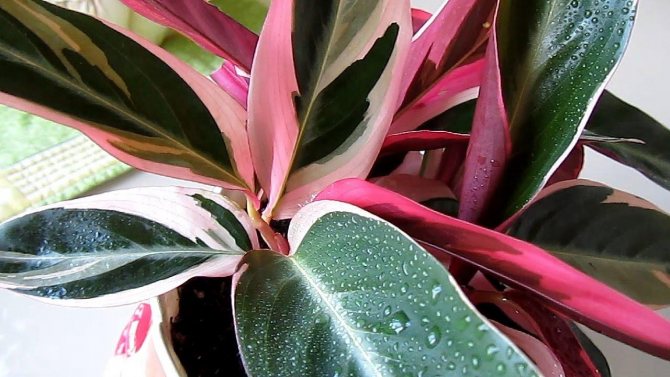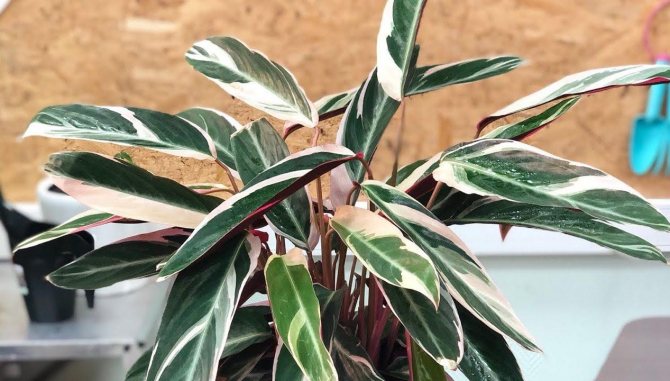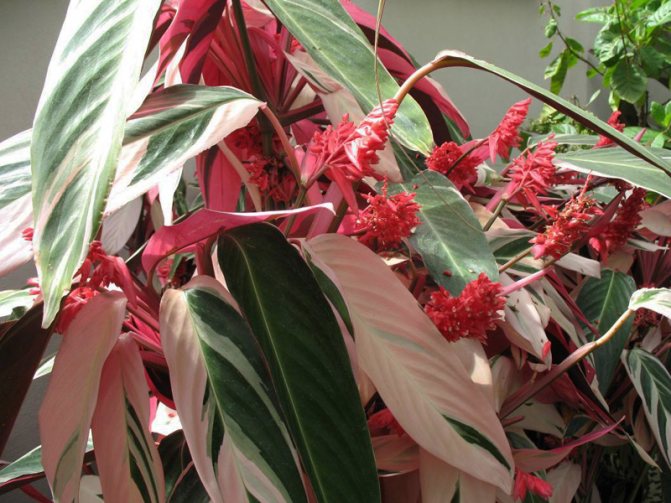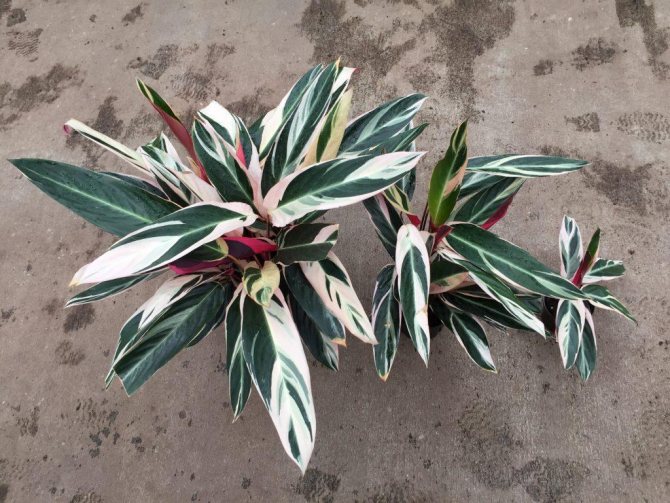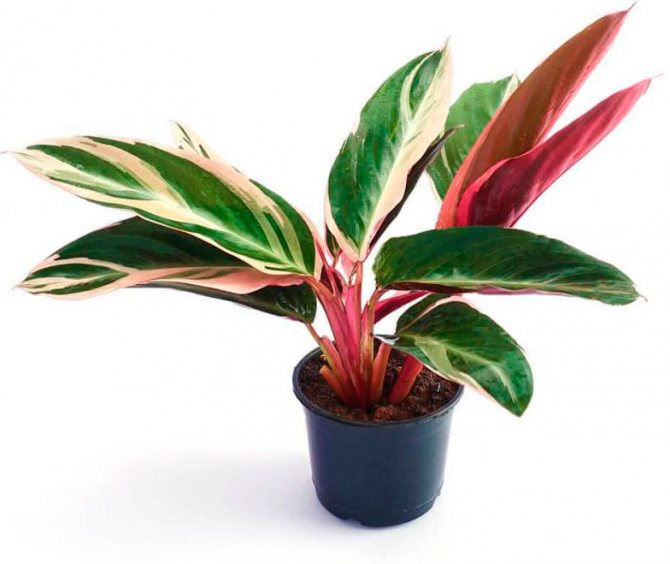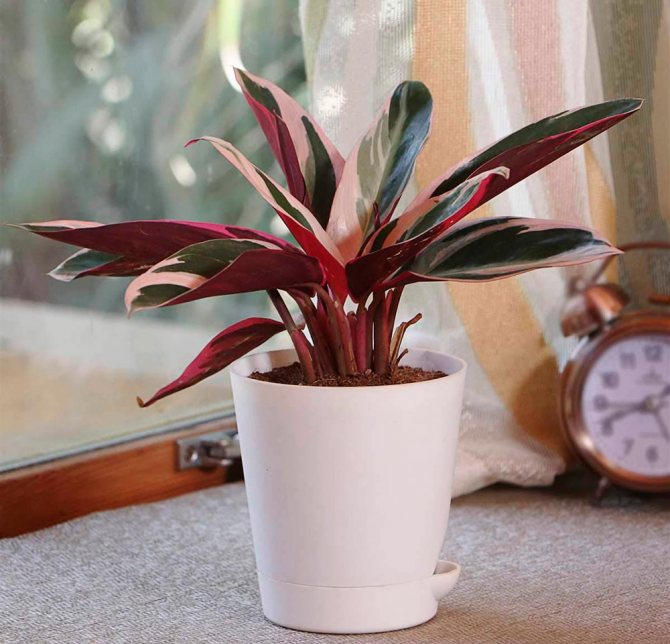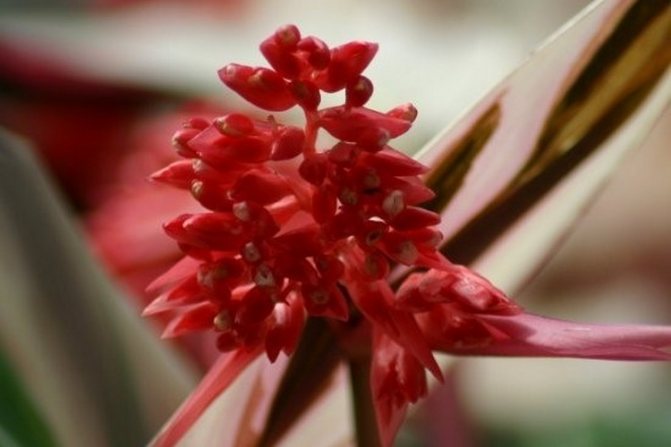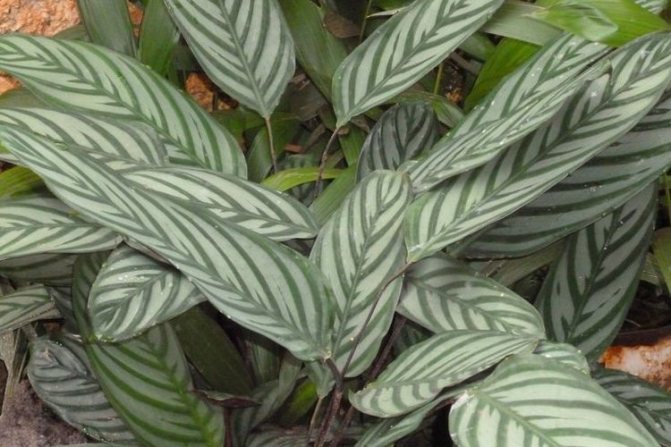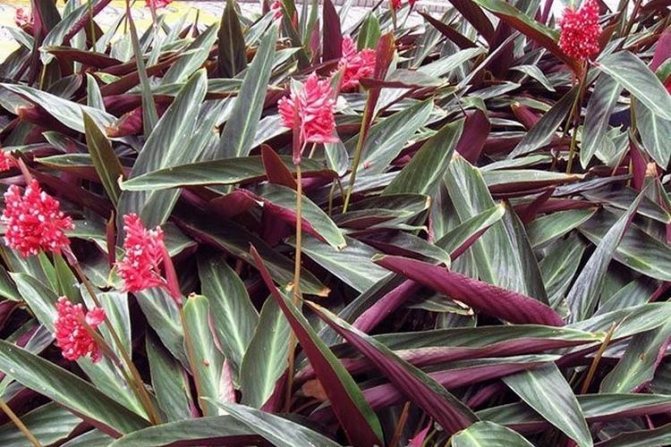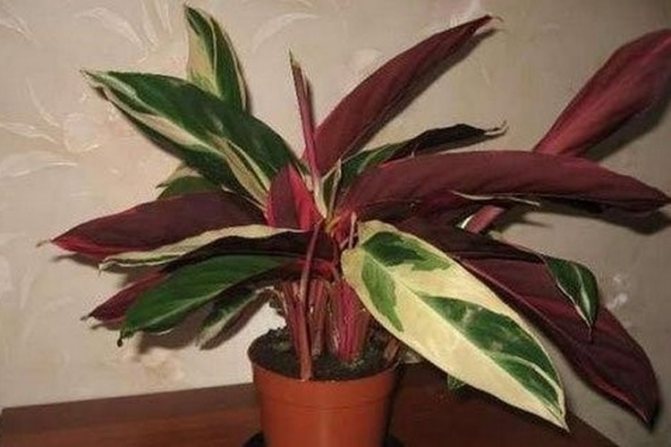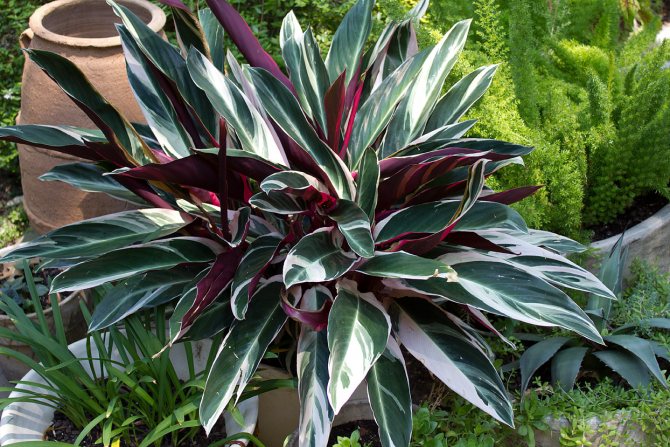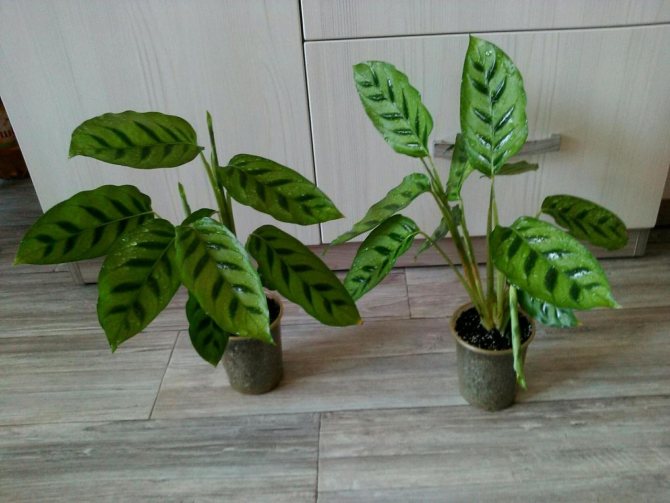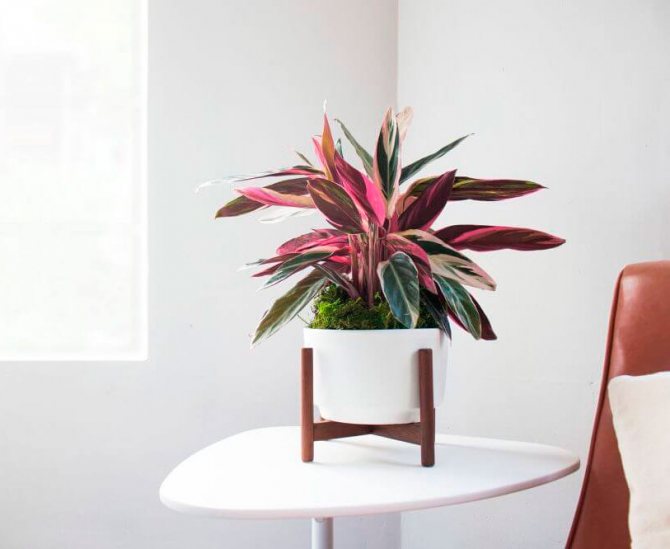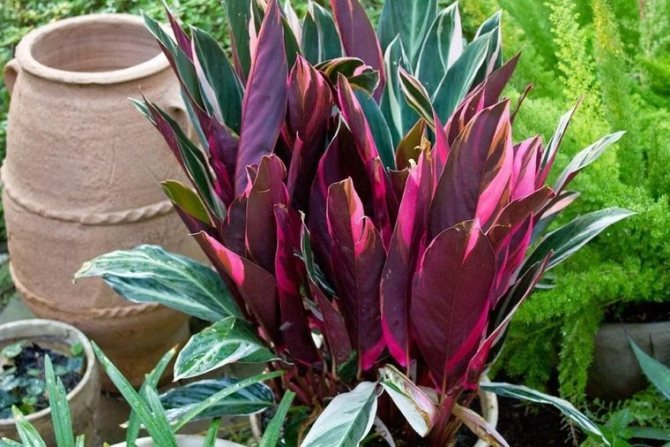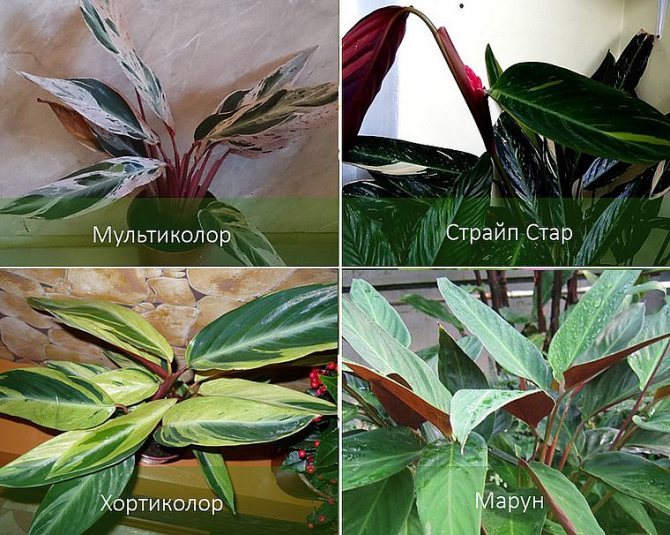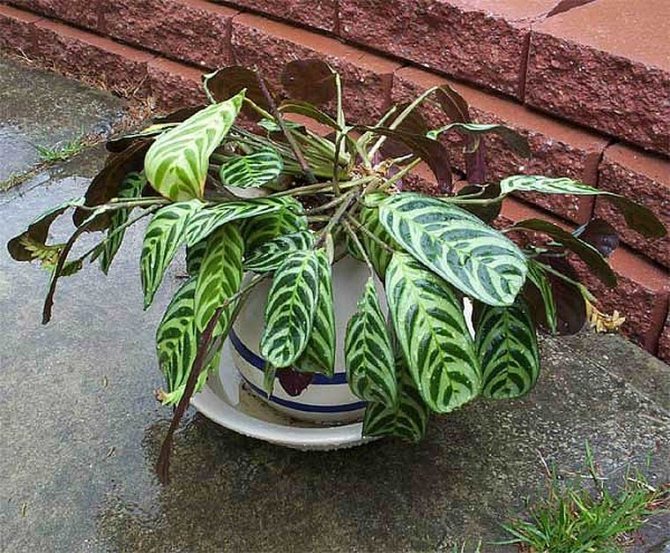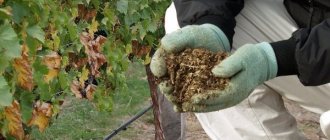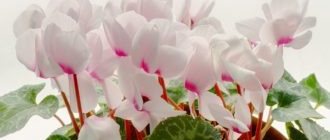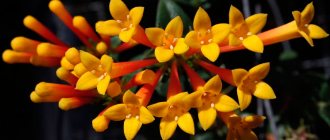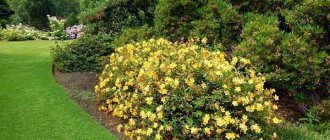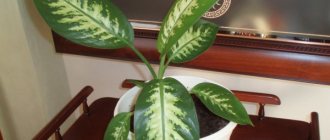Photo of the plant Stromanthe (Stromanthe) - a perennial herb from the Marantov family, combines 15 types. Natural habitat - tropics of South and Central America. Large lanceolate-linear or ovoid leaves reach a length of 15-40 cm.
The upper part of the leaf blade is light, dark or olive green with pink, cream or white irregular stripes along the leaf. The lower part of the leaf plate has a burgundy color. Due to the petiole structure, the leaves easily turn towards the sun. At night they fold up and rise up, and in the morning they fall down and open.
The plant produces 5-6 new leaves per year, growing up to 80 cm in height and width. At home, stromant rarely blooms. White or cream nondescript flowers are collected in spike-shaped inflorescences.
Stromanta conquers the hearts of flower growers with its decorative foliage with an unusual, seemingly painted color. However, such a breathtaking beauty is complemented by whimsical care, and it will take a lot of effort to admire the flower on your windowsill.
Also take a look at the Nertera plant.
| 6-7 new leaves per year. |
| Blooms in summer, very rarely. |
| The plant is difficult to grow. |
| Perennial. |
Beneficial features
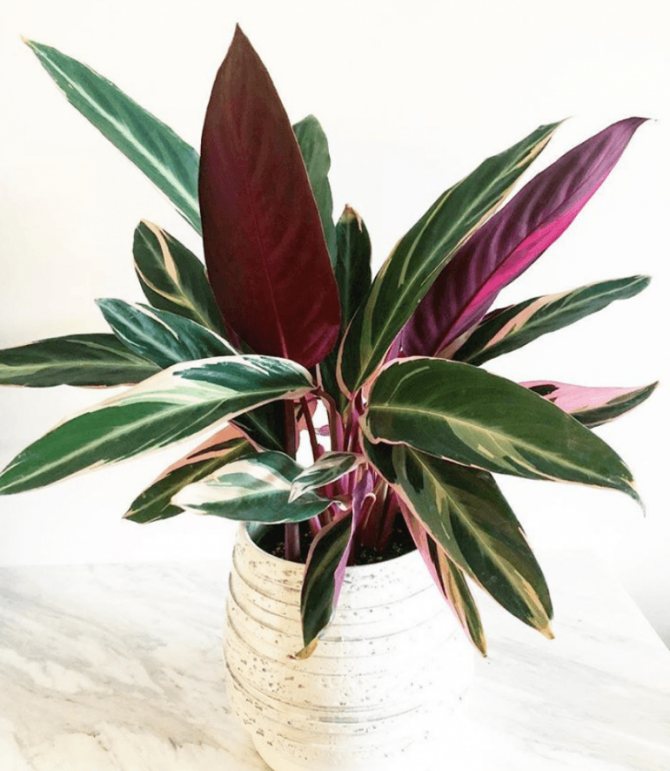
Photo of stromant in a pot
The plant is necessary for those who suffer from insomnia. It soothes the nervous system before bed, relieves stress and fatigue. There is also an opinion that stromanta helps to gain self-confidence, instills optimism, cheers up and gives additional vitality.
Features of growing at home. Briefly
Stromanta is very beautiful at home, but quite capricious. Therefore, it needs to comply with all the rules for caring for it:
| Temperature | In summer, during the period of active growth, it is 22-25 degrees, in winter - at least 18 degrees. Drafts and sudden temperature changes are unacceptable. |
| Air humidity | High, not less than 65%. Spraying the leaves daily with soft warm water is recommended. |
| Lighting | Diffused bright light, partial shade. |
| Watering | In summer - frequent and plentiful, every 4-5 days, as the soil dries up; in winter - moderate, no more than 1 time per week. |
| Priming | Breathable, with the addition of perlite or sand; drainage is required. |
| Top dressing and fertilization | During the growth period, every 2-3 weeks with a complex fertilizer for decorative deciduous plants, in a half dosage. |
| Transfer | At the end of spring in deep pots, young specimens are transplanted annually, adults - once every 3-5 years. |
| Reproduction | In the spring, when transplanting by dividing the bush; leafy rosettes, which are sometimes formed at the ends of the shoots; stem cuttings. |
| Growing features | In summer, you can take it out into the garden or on the balcony, it is important to remove completely dried leaves; fragile leaves are gently wiped with a soft cloth. |
Transfer
Young, fast growing specimens require replanting every year. It is held in mid-April. Adult bushes are transplanted every 2-3 years.
The pot is chosen 2 cm larger than the previous one. A thick drainage layer is poured into it. The shape of the container should be high, since drainage takes up at least ¼ of the entire volume of the pot.
Stromanta does not tolerate a transplant.
In order not to damage the roots of the plant, it is transplanted by transshipment. After transplanting, the plant is well watered.
Before transplanting, drainage from small expanded clay is laid on the bottom of the pot... This moisture-absorbing material will maintain the required soil moisture.
A layer of new soil mixture is poured on top so that the roots of the plant do not touch the drainage.
To easily remove the plant from the pot during transplanting and not break off the fragile roots, it is watered 1-2 days before this procedure. In this case, the earthy lump does not crumble. It can be removed and repositioned in the center of a larger container.
All voids in a new pot are filled with fresh soil. It is slightly compacted by tapping the sides of the pot with your hand. A thin layer of soil is laid on top of the earthen coma so that the transplanted plant is not too buried in the ground.
Stromantha care at home. In detail
Stromant at home requires very careful care. As a native of the tropics, it needs warmth and light, and especially a high humidity in the environment. However, if you strictly adhere to all the rules of care, the plant will certainly thank you with lush foliage and luxurious appearance.
Bloom
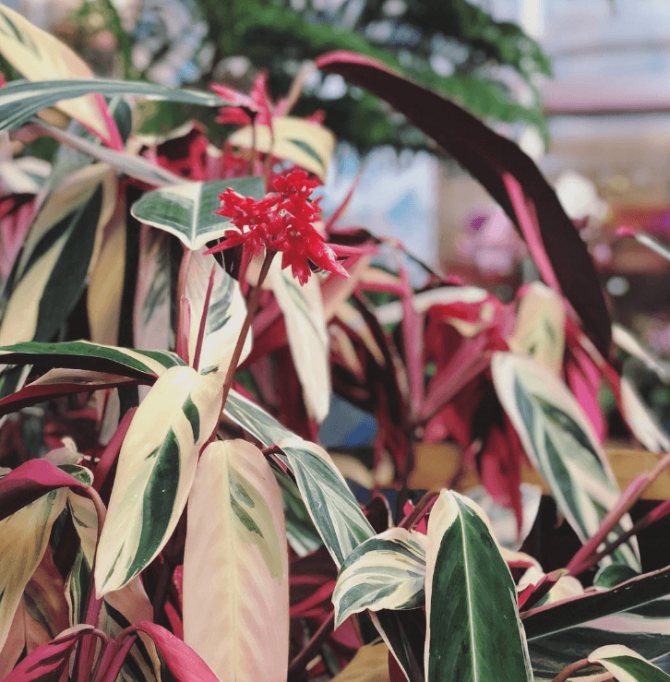

Inconspicuous white or creamy small flowers, in S. sanguinea they are bright red, on long peduncles they are collected in panicle inflorescences, 6-8 cm in diameter.
Flowers are not of decorative value. Stromanta blooms extremely rarely at home, only when ideal conditions are created.
Temperature regime
Stromantha is thermophilic. In summer, the optimum temperature for her is 22-27 degrees, in winter - 20-21 degrees, but not lower than 18. The plant does not tolerate temperature extremes. Therefore, the pot should be placed away from open vents and balcony doors. Hypothermia of the root system is fraught with the death of the flower.
Spraying
Home stromante needs high air humidity: ideally 90%, but not less than 70%. In view of this, the plant needs daily spraying with warm soft water, settled for several days. A fine spray is suitable for this purpose.
To increase the humidity, it is recommended:
- put the pot in a pallet with wet expanded clay or moss. In this case, the bottom of the flowerpot should not touch the water, so as not to rot the roots;
- put a container of water near the flower;
- put a wet cloth on the batteries in winter;
- cover the plant with a plastic bag at night;
- periodically gently wipe the leaves with a damp cloth.
Stromanta grows well in aquariums, mini-greenhouses, florariums, where it is easier to maintain high humidity.
Lighting
Room stromant needs bright, but diffused lighting. Lack of light or direct sunlight affects the leaves: they decrease in size and lose color. On cloudy winter days, artificial lighting is recommended.
The best place for the plant will be the eastern or western windowsill. On the south window, you will need shading, for example, with a translucent curtain. Can be grown under artificial lighting with fluorescent or phytolamps.
Moreover, she needs 16-hour daylight hours.
Watering
In spring and summer stromant needs frequent and abundant watering about 2-3 times a week... In the fall and spring, the frequency of watering is reduced to 1 time per week. The next moistening of the soil is carried out after the top layer of the earth in the pot has dried. After 20-30 minutes after watering, the water remaining in the pan is poured out. It is important to prevent stagnation of water in the pot - this is fraught with root rot.
Water for irrigation should be soft and warm. You can collect rainwater or defend tap water. Watering with cold water can provoke flower diseases.
Pot
Since the stromant has a developed root system, the pot should be chosen high. It should be 2-3 cm larger in diameter than the previous one.Drainage is laid out on the bottom (about ¼ of the pot). It is optimal that the pot is earthen: this will help to avoid rotting of the root system.
Priming
The earth should be good for air and moisture, be nutritious and slightly acidic (pH up to 6). From ready-made store mixes, a substrate for arrowroot, azalea or palm trees is suitable. If you prepare the soil yourself, you can choose one of the options:
- leafy soil, peat and sand in a ratio of 2: 1: 1;
- humus, leaf earth, sand and peat in a ratio of 1: 1: 1/2: 1;
- leafy ground (1), humus (1), turfy ground (1/2), sand (1), peat (1).
Top dressing and fertilization
Stromant is sensitive to an excess of mineral components in the soil, so you should not get too carried away with its fertilization. During the dormant period (from late autumn to early spring), fertilizing is not needed at all, during the growing season (mid-spring - mid-autumn) - once every 2-3 weeks.
It is optimal to use liquid complex fertilizers for ornamental deciduous plants. In this case, the concentration should be made 2 times weaker than indicated on the package.
Sometimes mineral supplements can be alternated with organic ones, such as mullein.
Stromant transplant
The stromant flower is transplanted at the end of spring by the transshipment method. Young specimens are transplanted annually, adults - every 3-5 years, as the entire space of the pot fills with the root system. At the same time, it is recommended to replace the top layer of soil in the pot (3-4 cm) every year.
With the next transplant, the plant is planted a little deeper than it was before. If, after transferring to a new pot, the leaves curl up, the flower should be placed in the shade and covered with a plastic bag to increase the humidity of the air.
Pruning
The plant does not need to form a crown. When transplanting, old dying leaves are removed. Throughout the year, completely dried leaves should be carefully trimmed.
Dormant period
The stromant has no pronounced rest period. However, from mid-autumn to early spring, it stops its growth and development. Due to the lack of natural lighting during this period, it is recommended to reduce the temperature of the plant to 18-20 degrees during this period.
Possible problems
Stromanta dries
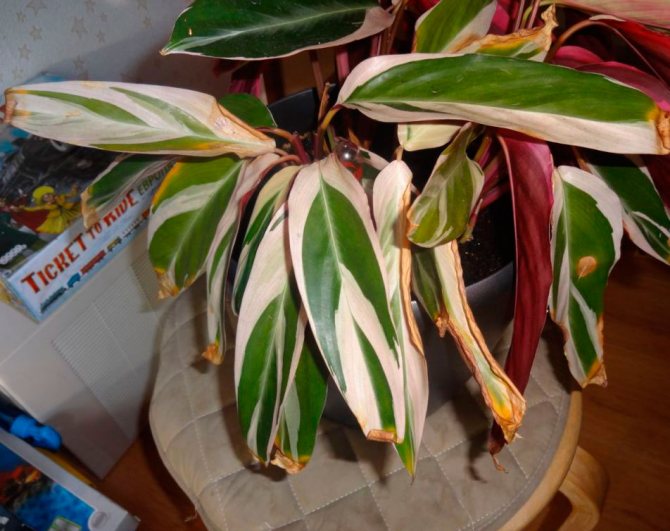

Often, flower growers are faced with such a problem - at the room stromant, leaf plates begin to dry out. This may be due to a too low level of humidity or spider mites on the bush, which also prefer dry air. Moisten the flower from the spray bottle as often as possible, while making sure that the expanded clay in the pallet is wet all the time. The leaf plates are treated with a soft sponge dipped in a solution of soap, the agent is washed off the bush only after 3-4 hours. After that, it is removed under a plastic bag so that the pest will die for sure. In the event that after the "soapy" treatment the tick does not die, then the bush is sprayed with Actellik solution, which is highly effective.
It also happens that at first the foliage loses its rich color, and then it begins to dry out. This happens when the lighting is overly bright. In this case, the bush is transferred to light partial shade, or it is protected from direct midday sunlight.
Twisting the foliage
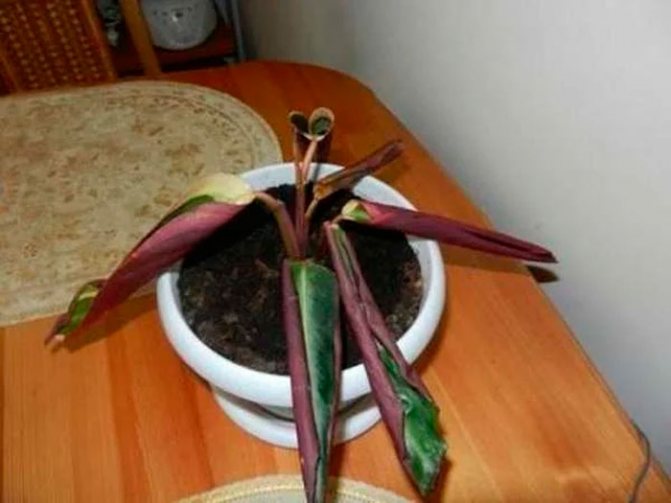

If the conditions for keeping the stromant are violated, then this will certainly affect the state of its leaves. For example, if the bush is watered incorrectly, then its leaves may begin to dry out, or they curl up and specks form on them. With a lack of moisture, as well as with stagnation of liquid in the root system, the leaves of such a flower will curl and fly around. Remember that the soil mixture in the pot should always be a little damp, in no case do not allow it to dry out, as well as stagnation of moisture in the roots.
The stromant's leaves wither
If the foliage withers and rot appears on the shoots, this indicates that the room has a very high level of humidity, but it is too cold. In order to remedy the situation, the air humidity is not lowered, but the temperature is raised to 25-30 degrees.
Pests
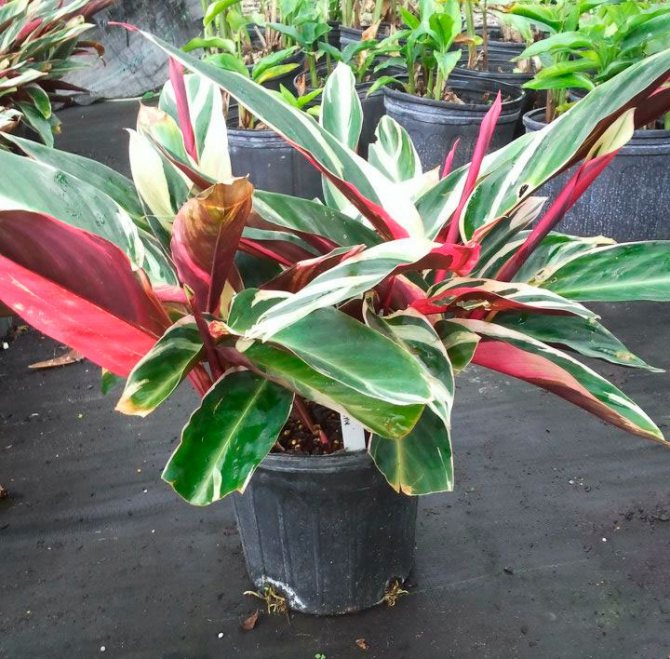

Scales, whiteflies, thrips, spider mites and mealybugs can settle on the bush. In order to get rid of spider mites, thrips and whiteflies, the plant is treated with Actellik's solution. The contents of one ampoule of the drug are added to 1 liter of water, the resulting solution is abundantly moistened with a bush using a spray bottle, after which a transparent bag is put on top of it, it is removed only after 24 hours. If one treatment is not enough to destroy the pest, then repeat processing is carried out after 7-15 days.
To destroy aphids, it is recommended to use Inta-vir or Fitoverm. To exterminate mealybugs, the following remedy is prepared: a small amount of hot water is combined with 1 tsp. crushed soap (you can take any). Add enough water to the mixture so that you end up with a volume of 1 liter, and then pour 2 tbsp into the solution. l. vodka. Mix everything well and moisten the bush with the agent, while do not forget to protect the surface of the soil mixture in the container with a film. After 24 hours, rinse the bush by removing soap from it, while the surface of the substrate is protected from the solution. In total, to destroy the pest, it will take 3 or 4 treatments with such a soap mixture, which are carried out with a break of 7 days. The soap can be replaced with dishwashing detergent.
Reproduction
Stromanta reproduces in two main ways.
Reproduction of stromant by dividing the bush
The most convenient way to carry out the procedure is during the transplant.
- A large plant is carefully divided into 2-3 parts, trying to minimize the damage to the root system.
- New specimens are planted in shallow pots filled with a peat-based substrate and watered well with warm, settled water.
- Before the next moistening, the soil should dry well.
- The containers are covered with a plastic bag to increase humidity and placed in a warm place.
The "greenhouse" can be opened when the plants harden and new leaves appear.
Reproduction of stromant by cuttings
The procedure is best done in late spring or early summer.
- Cuttings are cut from young shoots of the plant, 7-10 cm long, having 2-4 leaves.
- The cut is made slightly below the point where the leaf is attached to the stem.
- The cuttings are placed in a glass of water, which is covered with a plastic bag to increase the humidity of the air.
- To prevent the stalk from rotting, 1-2 tablets of crushed activated carbon can be added to the glass.
The rooting process lasts 5-6 weeks, after which the cuttings are planted in peat soil. The containers are covered with polyethylene and placed in a warm place.
Zodiac sign combination
Stromants are suitable for most people, as they contribute to the formation of strong character traits. But she has a special favor for Aquarius.
It is undesirable to have such a flower for the following zodiac signs:
- Aries: knocks down personal energy and brings discomfort;
- twins: complete incompatibility;
- Leo: It introduces an imbalance on the energy level, has a negative impact, and can be destructive.


Such a flower can be presented as a gift to friends, acquaintances and close people who have problems in their personal and family life. Only the whimsicality of the plant and its need for careful care should be taken into account. Therefore, the plant is not suitable for people who are unable to provide him with appropriate care.
Diseases and pests
Problems most often arise from non-compliance with the conditions of its containment. Here are the main difficulties and their reasons:
- Leaves fade and dry - excess lighting, direct sunlight.
- Growing slowly - too dry air in the room, lack or excess of minerals.
- Leaves fold overnight - a normal occurrence, this is a feature of the plant.
- Leaves fade - lack of lighting; leaves can lose color due to excess sunlight.
- The lower leaves dry up - the result of the natural aging process of the flower.
- Stalks rot - too low temperature of the content and waterlogging of the soil.
- Leaves stromant wither and turn yellow - waterlogging of the soil.
- Leaf tips dry - too dry air, possibly spider mite damage.
- The leaves of the stromant are covered with dark spots - insufficient soil moisture.
- Leaves curl - insufficient watering, long breaks between soil moisture.
- Leaves fall - soil acidification due to excessive watering, low environmental humidity.
- The appearance of yellow-brown spots on the leaves - lack of minerals.
It is affected by whitefly, scale insects, aphids, spider mites, mealybugs.
Types of home stromant with photos and names
Stromanthe amabilis


Reaches a height of 30 cm. It has broadly oval long-petiolized leaves 10–20 cm long and 4–5 cm wide. The upper part of the leaf plate is light green with dark green stripes spreading like a herringbone from the central vein. The underside of the leaf is gray-green with a pink tint.
Stromanthe sanguinea
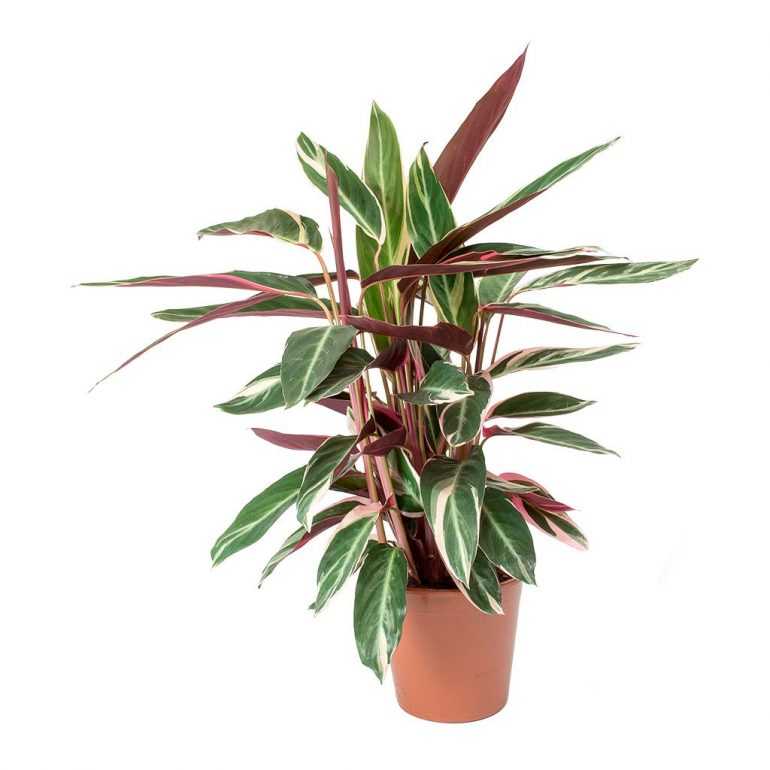

Height is 40-50 cm. Oval pointed leaves reach 30-40 cm in length, 7-13 cm in width. The upper part of the leaf plate is glossy, light green with V-shaped dark green strokes, the lower one has a burgundy hue.
Common varieties of blood-red stromant are:
- Tricolor - dark green leaves are covered with multi-colored stains from white and pink to light green, the lower part of the leaf plate is burgundy;
- Triostar - the leaves are decorated with yellow, olive and light green stripes;
- Maroon - deep green leaves with a more pronounced light green central vein;
- Multicolor - dark green leaves with white and light green spots.
Stromanta is a capricious beauty. But if you devote time to it with love and attention and create the necessary conditions, it will delight you with bright lush foliage and become a real decoration of your home!
Description of the plant
Stromanta is a genus of perennial evergreen plants of the Marantovaya family. The homeland of this flower is the rainforests of South and Central America. In a natural environment, plant height can reach 2 m, and the length of the leaves often exceeds 50-60 cm. Indoor varieties are compact in size, on average they grow only up to 80 cm.
The stromant has gained great popularity thanks to its bright green leaves with a decorative pattern of vanilla, salad, yellow or pinkish shades. The reverse side of the leaf blades is very delicate, reminiscent of silk. During the day, the leaves turn in the direction of the sun's movement, due to which the plant has received the name "prayer flower". Towards evening, they take a vertical shape and curl into a tube.
The plant is always in motion and is often planted in a group, giving the impression of a beautiful textured carpet. It is very difficult to achieve flowering at home. Outwardly, the flowers are very small and inconspicuous, located on a long peduncle. They have a strong and pleasant aroma that attracts many insects.



